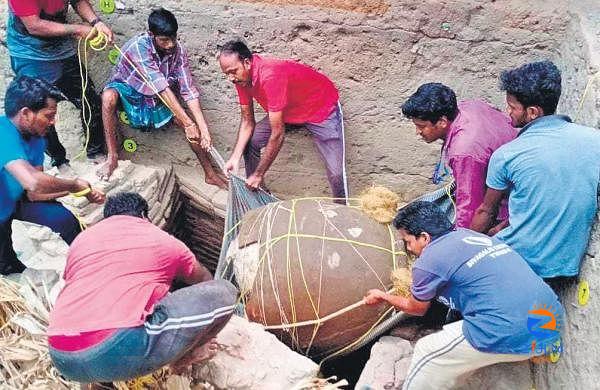
[ad_1]
Express News Service
THOOTHUKUDI: The artefacts found at Korkai has brought to light the ancient port city’s trade relations with the Eastern countries, Egypt and Ganges plain. Earlier, the excavations unearthed a perforated pipe and a brick structure, chunk cutting factories in Korkai, hinting at a busy industrial activity. The archaeologists of the Department of Archaeology of Tamil Nadu excavating the Korkai site had found two storage jars one above the other, within a brick structure at a trench in Korkai. The experts had managed to unearth one jar while another had been excavated until its neck portion.
“The antique storage jar was found at the depth of five feet and it was surrounded by a brick structure on all its sides. The storage jar is four feet in height and three feet in diameter,” said the site director Thangadurai. The possibility of unearthing the other jar below is bleak as ground water had sprung, he added.
A black polished potsherd which was prominently used in river Ganges plains, was found inside the storage jar. “It reveals the trade relations between the Ganges plains and Porunai plains,” he said. When Bishop Robert Caldwel excavated Korkai in 1876, he unearthed an large urn having 11 feet in circumference.
A few feet away, the archaeologists found remains of a Torpedo jar, which is used to bring oil from Egypt. The archaeologists said, the Torpedo jar is a large handle-less pot having a narrow neck. It was found nearly 10 feet away from the perforated pipe, unearthed recently. “Torpedo jar must be used to transport oil and other liquid commodities from Egypt to Korkai,” the archaeologist said, adding the sample has also been confirmed with the Egyptian counterparts. Torpedo jar again proves its overseas trade links with Egypt.
Also, the archaeologists had discovered a Chinese ware that emphatically proves its trade relations with Eastern countries, said the site director. The Korkai, the capital of Pandyan kingdom, is already renowned for pearl fishery. It finds its name in the Tamil sangam literature, and in the travel notes of Claudius Ptolemy, who travelled the southern peninsula in the second century, and in the Periplus of the Erythrean Sea. While Ptolemy refers to Korkai as ‘kolkhic’, it is mentioned as ‘Colchis’ in Periplus, which was a key maritime trade guide used by the Gulf traders in the first century.
Archaeological enthusiast Muthalakurichi Kamarasu said that it is for the first time evidence of Korkai’s trade with Eastern countries and Ganges plains are found. “While the Chola empire’s trade links are known in detail, the current excavations at Korkai will reveal the trade and industrial activity of Pandyas,” he said.
Connecting the dots
The Korkai finds its name in the Tamil sangam literature, and in the travel notes of Claudius Ptolemy, who travelled the southern peninsula in 2nd century, and in the Periplus of the Erythrean Sea
[ad_2]